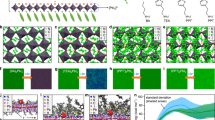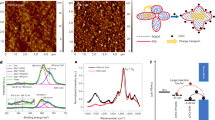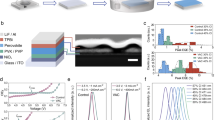Abstract
Light-emitting diodes based on halide perovskites have recently reached external quantum efficiencies of over 20%. However, the performance of visible perovskite light-emitting diodes has been hindered by non-radiative recombination losses and limited options for charge-transport materials that are compatible with perovskite deposition. Here, we report efficient, green electroluminescence from mixed-dimensional perovskites deposited on a thin (~1 nm) lithium fluoride layer on an organic semiconductor hole-transport layer. The highly polar dielectric interface acts as an effective template for forming high-quality bromide perovskites on otherwise incompatible hydrophobic charge-transport layers. The control of crystallinity and dimensionality of the perovskite layer is achieved by using tetraphenylphosphonium chloride as an additive, leading to external photoluminescence quantum efficiencies of around 65%. With this approach, we obtain light-emitting diodes with external quantum efficiencies of up to 19.1% at high brightness (>1,500 cd m−2).
This is a preview of subscription content, access via your institution
Access options
Access Nature and 54 other Nature Portfolio journals
Get Nature+, our best-value online-access subscription
$29.99 / 30 days
cancel any time
Subscribe to this journal
Receive 12 digital issues and online access to articles
$119.00 per year
only $9.92 per issue
Buy this article
- Purchase on Springer Link
- Instant access to full article PDF
Prices may be subject to local taxes which are calculated during checkout




Similar content being viewed by others
Data availability
The research data supporting this paper are available in the University of Cambridge Repository (www.repository.cam.ac.uk). Related research results are available from the corresponding authors upon reasonable request.
References
Wehrenfennig, C., Eperon, G. E., Johnston, M. B., Snaith, H. J. & Herz, L. M. High charge carrier mobilities and lifetimes in organolead trihalide perovskites. Adv. Mater. 26, 1584–1589 (2014).
Stranks, S. D. et al. Electron-hole diffusion lengths exceeding 1 micrometer in an organometal trihalide perovskite absorber. Science 342, 341–344 (2013).
Xing, G. et al. Long-range balanced electron- and hole-transport lengths in organic-inorganic CH3NH3PbI3. Science 342, 344–347 (2013).
Hattori, T., Taira, T., Era, M., Tsutsui, T. & Saito, S. Highly efficient electroluminescence from a heterostructure device combined with emissive layered-perovskite and an electron-transporting organic compound. Chem. Phys. Lett. 254, 103–108 (1996).
Mitzi, D. B., Chondroudis, K. & Kagan, C. R. Organic-inorganic electronics. IBM J. Res. Dev. 45, 29–45 (2001).
Deschler, F. et al. High photoluminescence efficiency and optically pumped lasing in solution-processed mixed halide perovskite semiconductors. J. Phys. Chem. Lett. 5, 1421–1426 (2014).
Sutherland, B. R. & Sargent, E. H. Perovskite photonic sources. Nat. Photon. 10, 295–302 (2016).
Kojima, A., Teshima, K., Shirai, Y. & Miyasaka, T. Organometal halide perovskites as visible-light sensitizers for photovoltaic cells. J. Am. Chem. Soc. 131, 6050–6051 (2009).
Lee, M. M., Teuscher, J., Miyasaka, T., Murakami, T. N. & Snaith, H. J. Efficient hybrid solar cells based on meso-superstructured organometal halide perovskites. Science 338, 643–647 (2012).
Kim, H.-S. et al. Lead iodide perovskite sensitized all-solid-state submicron thin film mesoscopic solar cell with efficiency exceeding 9%. Sci. Rep. 2, 591 (2012).
Green, M. A., Ho-Baillie, A. & Snaith, H. J. The emergence of perovskite solar cells. Nat. Photon. 8, 506–514 (2014).
Dou, L. et al. Solution-processed hybrid perovskite photodetectors with high detectivity. Nat. Commun. 5, 5404 (2014).
Fang, Y., Dong, Q., Shao, Y., Yuan, Y. & Huang, J. Highly narrowband perovskite single-crystal photodetectors enabled by surface-charge recombination. Nat. Photon. 9, 679–686 (2015).
Tan, Z.-K. et al. Bright light-emitting diodes based on organometal halide perovskite. Nat. Nanotechnol. 9, 687–692 (2014).
Cho, H. et al. Overcoming the electroluminescence efficiency limitations of perovskite light-emitting diodes. Science 350, 1222–1225 (2015).
Yuan, M. et al. Perovskite energy funnels for efficient light-emitting diodes. Nat. Nanotechnol. 11, 872–877 (2016).
Wang, N. et al. Perovskite light-emitting diodes based on solution-processed self-organized multiple quantum wells. Nat. Photon. 10, 699–704 (2016).
Zhao, B. et al. High-efficiency perovskite–polymer bulk heterostructure light-emitting diodes. Nat. Photon. 12, 783–789 (2018).
Chiba, T. et al. Anion-exchange red perovskite quantum dots with ammonium iodine salts for highly efficient light-emitting devices. Nat. Photon. 12, 681–687 (2018).
Cao, Y. et al. Perovskite light-emitting diodes based on spontaneously formed submicrometre-scale structures. Nature 562, 249–253 (2018).
Lin, K. et al. Perovskite light-emitting diodes with external quantum efficiency exceeding 20 per cent. Nature 562, 245–248 (2018).
Di, D. et al. Size-dependent photon emission from organometal halide perovskite nanocrystals embedded in an organic matrix. J. Phys. Chem. Lett. 6, 446–450 (2015).
Li, G. et al. Efficient light-emitting diodes based on nanocrystalline perovskite in a dielectric polymer matrix. Nano Lett. 15, 2640–2644 (2015).
Ban, M. et al. Solution-processed perovskite light emitting diodes with efficiency exceeding 15% through additive-controlled nanostructure tailoring. Nat. Commun. 9, 3892 (2018).
Xu, W. et al. Rational molecular passivation for high-performance perovskite light-emitting diodes. Nat. Photon. 13, 418–424 (2019).
Di, D. et al. High-performance light-emitting diodes based on carbene-metal-amides. Science 356, 159–163 (2017).
Xiao, Z. et al. Efficient perovskite light-emitting diodes featuring nanometre-sized crystallites. Nat. Photon. 11, 108–115 (2017).
Gerenser, L. J. XPS studies of in situ plasma-modified polymer surfaces. J. Adhes. Sci. Technol. 7, 1019–1040 (1993).
Si, J. et al. Efficient and high-color-purity light-emitting diodes based on in situ grown films of CsPbX3 (X = Br, I) nanoplates with controlled thicknesses. ACS Nano 11, 11100–11107 (2017).
Shi, Y. et al. A strategy for architecture design of crystalline perovskite light-emitting diodes with high performance. Adv. Mater. 30, 1800251 (2018).
Stolterfoht, M. et al. Visualization and suppression of interfacial recombination for high-efficiency large-area pin perovskite solar cells. Nat. Energy 3, 847–854 (2018).
Yeh, S.-J. et al. New dopant and host materials for blue-light-emitting phosphorescent organic electroluminescent devices. Adv. Mater. 17, 285–289 (2005).
Aizawa, N. et al. Solution-processed multilayer small-molecule light-emitting devices with high-efficiency white-light emission. Nat. Commun. 5, 5756 (2014).
Chen, M., Shan, X., Geske, T., Li, J. & Yu, Z. Manipulating ion migration for highly stable light-emitting diodes with single-crystalline organometal halide perovskite microplatelets. ACS Nano 11, 6312–6318 (2017).
Kulkarni, A. P., Tonzola, C. J., Babel, A. & Jenekhe, S. A. Electron transport materials for organic light-emitting diodes. Chem. Mater. 16, 4556–4573 (2004).
Sim, K. et al. Performance boosting strategy for perovskite light-emitting diodes. Appl. Phys. Rev. 6, 031402 (2019).
Xiao, C. et al. Mechanisms of electron-beam-induced damage in perovskite thin films revealed by cathodoluminescence spectroscopy. J. Phys. Chem. C 119, 26904–26911 (2015).
Divitini, G. et al. In situ observation of heat-induced degradation of perovskite solar cells. Nat. Energy 1, 15012 (2016).
Yang, L., Kim, V., Lian, Y., Zhao, B. & Di, D. High-efficiency dual-dopant polymer light-emitting diodes with ultrafast inter-fluorophore energy transfer. Joule 3, 2381–2389 (2019).
Greenham, N. C., Friend, R. H. & Bradley, D. D. C. Angular dependence of the emission from a conjugated polymer light-emitting diode: implications for efficiency calculations. Adv. Mater. 6, 491–494 (1994).
Forrest, S. R., Bradley, D. D. C. & Thompson, M. E. Measuring the efficiency of organic light-emitting devices. Adv. Mater. 15, 1043–1048 (2003).
de Mello, J. C., Wittmann, H. F. & Friend, R. H. An improved experimental determination of external photoluminescence quantum efficiency. Adv. Mater. 9, 230–232 (1997).
Stoumpos, C. C. et al. Crystal growth of the perovskite semiconductor CsPbBr3: a new material for high-energy radiation detection. Cryst. Growth Des. 13, 2722–2727 (2013).
Shibuya, K., Koshimizu, M., Nishikido, F., Saito, H. & Kishimoto, S. Poly[bis(phenethylammonium) [dibromidoplumbate(ii)]-di-μ-bromido]]. Acta Crystallogr. Sect. E 65, m1323–m1324 (2009).
Acknowledgements
This work was supported by the National Key Research and Development Program of China (grant no. 2018YFB2200401), the National Natural Science Foundation of China (NSFC) (61975180, 51702289), the Fundamental Research Funds for the Central Universities (2019QNA5005) and Zhejiang University Education Foundation Global Partnership Fund. G.D. acknowledges funding from EU H2020 grant no. 823717–ESTEEM3. R.A.O. and G.K. acknowledge financial support from the Engineering and Physical Sciences Research Council (EPSRC) (under EP/R025193/1) and from Attolight. We thank C. Monachon of Attolight for his ongoing support of the TRCL system. E.R. and S.D.S. acknowledge the European Research Council (ERC) under the European Union’s Horizon 2020 research and innovation programme (HYPERION, grant agreement no. 756962). E.R. acknowledges partial funding from an EPSRC Departmental Graduate Studentship. S.D.S. acknowledges the Royal Society and Tata Group (UF150033). We used beamline I07 at the Diamond Light Source (proposal SI17223). W.L. and J.L.M.-D. acknowledge support from EPSRC grant EP/L011700/1 and EP/N004272/1 and the Isaac Newton Trust (Minute 13.38(k)). B.Z. acknowledges support from China Scholarship Council and Cambridge Commonwealth, European and International Trust. This project has received funding from the ERC under the European Union’s Horizon 2020 research and innovation programme (grant agreement no. 670405). We thank the EPSRC for support.
Author information
Authors and Affiliations
Contributions
B.Z. planned the project under the guidance of D.D and R.H.F. B.Z. and L.C. developed and characterized the high-efficiency LEDs. Y.L. performed experiments and analyses related to LiF and other polar interfaces. B.Z. and L.C. carried out the PL, PLQE, transient (ns–μs) PL, XRD and SEM studies. F.A. built the crystalline structure model based on the XRD results. Y.L. and D.Y. performed the cross-sectional TEM studies. E.R. carried out the GIWAXS measurements and analysis. G.D., G.K. and B.Z. performed the CL mapping and transient CL studies. G.D. analysed the CL results. W.L. analysed the UPS and XPS results. B.Z., D.D. and L.C. wrote the manuscript, which was revised by R.H.F. All the authors contributed to the work and commented on the paper.
Corresponding authors
Ethics declarations
Competing interests
R.H.F. is a director of Helio Display Materials Ltd. The remaining authors declare no competing interests.
Additional information
Publisher’s note Springer Nature remains neutral with regard to jurisdictional claims in published maps and institutional affiliations.
Extended data
Extended Data Fig. 1 Absorption and PL spectra of mixed-dimensional perovskites.
a, with no additive. b, with 5% TPPCl inclusion. The perovskite samples are deposited on fused silica substrates. The dashed lines in (a), mark the absorption peaks of the n = 1, n = 2, n = 3 and n≈ ∞ (3D) phases and n = 2, n = 3 and n≈ ∞ (3D) phases in (b).
Extended Data Fig. 2 XPS measurements of perovskite samples.
a, C 1s; b, O 1s; c, Pb 4f; d, Br 3d; and e, Cs 3d spectra for perovskite film surface with different TPPCl content. The binding energy scale was calibrated to C 1 s at 284.8 eV.
Extended Data Fig. 3 UPS spectra of perovskite samples.
a, UPS spectra close to the onset region for perovskite films with TPPCl molar inclusion of 0% (no additive); b, 2%; c, 5%; and d, 8%. Valence band spectra of perovskite films with TPPCl molar inclusion of e, 0% (no additive); f, 2%; g, 5%; and h, 8%.
Extended Data Fig. 4 GIWAXS patterns.
a, GIWAXS patterns of perovskite with no additive; b, perovskite with 2% TPPCl; c, perovskite with 5% TPPCl; and d, perovskite with 8% TPPCl, deposited on Si substrates.
Extended Data Fig. 5 Structural analysis of the perovskite active layer.
a, Comparison of the experimental XRD pattern with the simulated patterns of the CsPbBr3 bulk phase43 and the layered PEA2PbBr4 (n = 1)44. The grey lines indicate the 020 and the 040 reflections of the bulk phase. No periodically ordered PEA2PbBr4 or other layered phases (the 00l reflections of the n = 2 and n = 3 phases would be shifted to slightly smaller angles) are observed in the experimental pattern. The broad peak around 20° is due to the fused silica substrate. b, Crystal structures of the bulk and the n = 1 perovskite phases. c, Schematic representation of the orientation of the perovskite domains on the substrate. The b-axis is aligned parallel the substrate normal (that is, the {020} planes are parallel to the substrate surface), while the individual domains are rotated about the substrate normal (planar disorder). d, While the optical measurements confirm the presence of low-dimensional perovskite layers, these do not show up as separate phases with translational symmetry in the XRD and GIWAXS patterns. The low-dimensional layers might instead be incorporated in grains of the CsPbBr3 bulk phase.
Extended Data Fig. 6 Analysis of texture of the perovskite films.
For the analysis of the texture, we performed radial integrations of the four GIWAXS patterns shown in Extended Data Fig. 4. We focus on the 022 reflection at qradial=1.5 Å−1, since this is the most intense reflection that is not affected by the sample horizon or Yoneda peak. The integral over the 20°–70° range provides an approximate measure of the total intensity of this reflection, while the 40°–50° integral captures only the oriented domains. The ratio between these two integrals is about 0.4 and remains constant within experimental error up to 5% TPPCl, indicating that in this range the additive improves the overall crystallinity and the optoelectronic properties, but does not affect the crystallite orientation.
Extended Data Fig. 7 Photo taken under UV illumination after spin-coating perovskite on TFB (left) and LiF-coated TFB (right) substrates.
Perovskite cannot form on the TFB surface without LiF due to hydrophobicity.
Extended Data Fig. 8 Additional characterizations of perovskite LEDs.
a, Angular emission profile of the perovskite LEDs. The angular emission data closely resembles the Lambertian profile. b, Comparison of current-voltage characteristics between devices with structures of ITO/TFB/LiF (1 nm)/perovskite/TPBi (50 nm)/LiF/Al and ITO/TFB/LiF(1 nm)/TPBi (50 nm)/LiF/Al. c, Comparison of current-voltage characteristics between devices with structures of ITO/TPBi/LiF/Al, ITO/LiF/TPBi/LiF/Al and ITO/TFB/LiF/TPBi/LiF/Al. d, Comparison of current-voltage characteristics between devices with different thickness of LiF, ITO/TFB/LiF(0,1,2,5 nm)/TPBi/LiF/Al.
Extended Data Fig. 9 CL intensity distributions of perovskite samples.
The vertical axis represents the number of pixels with a given measured CL intensity. Distributions peaked more towards the right indicate a stronger emission from the sample.
Extended Data Fig. 10 Transient CL characteristics.
a, Transient CL mapping of perovskite films with no additive; b, with 5% TPPCl; and c, perovskite with 5% TPPCl deposited on LiF-coated substrate. d, CL kinetics of perovskite films.
Supplementary information
Supplementary Information
Supplementary Figs. 1 and 2 and Tables 1–5.
Rights and permissions
About this article
Cite this article
Zhao, B., Lian, Y., Cui, L. et al. Efficient light-emitting diodes from mixed-dimensional perovskites on a fluoride interface. Nat Electron 3, 704–710 (2020). https://doi.org/10.1038/s41928-020-00487-4
Received:
Accepted:
Published:
Issue Date:
DOI: https://doi.org/10.1038/s41928-020-00487-4
This article is cited by
-
Phase dimensions resolving of efficient and stable perovskite light-emitting diodes at high brightness
Nature Photonics (2024)
-
Charge transport in mixed metal halide perovskite semiconductors
Nature Materials (2023)
-
Light management for perovskite light-emitting diodes
Nature Nanotechnology (2023)
-
In-situ growth of low-dimensional perovskite-based insular nanocrystals for highly efficient light emitting diodes
Light: Science & Applications (2023)
-
Bright and stable perovskite light-emitting diodes in the near-infrared range
Nature (2023)



